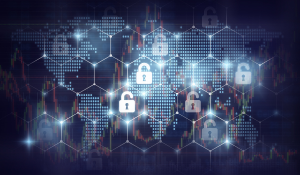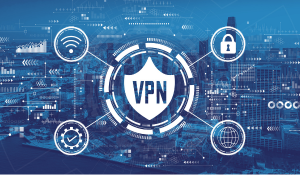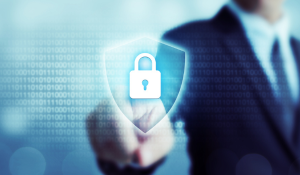How Encryption Safeguards Confidential Information
In a time characterized by growing online dangers and strict regulations surrounding data privacy, the significance of encryption in safeguarding...

Digital communication has become an integral part of our everyday lives, and with it comes a growing need for security and privacy. In a world where personal messages, confidential business data and sensitive information are increasingly exchanged online, protecting this data is becoming ever more important. This is where end-to-end encryption comes into play - a technology that ensures that only the intended recipients have access to the content of our digital communications.
End-to-end encryption (E2EE) protects digital communications by ensuring that only the endpoints involved (sender and receiver) have access to the messages. The data is encrypted on the sender device and decrypted on the recipient device so that it cannot be read by third parties, including service providers or network operators, while in transit.
E2EE offers several benefits, including maximum confidentiality, protection against interception and eavesdropping, data integrity and protection against data breaches. It also secures against government surveillance and ensures that cloud data remains protected even if the cloud provider is compromised.
E2EE also has challenges, such as the complexity of key management, legal and political controversies regarding accessibility for law enforcement, and technical limitations such as the potential threat of quantum computing. It is not a universal solution for all cyber threats.
E2EE is crucial for companies to protect confidential data such as financial and customer information. It minimizes the risk of data theft and strengthens confidence in IT security by ensuring that intercepted data remains unreadable.
The future of E2EE will be influenced by technological advances, such as the need for quantum-resistant algorithms and adapted solutions for the Internet of Things (IoT).Improvements in key management and user-friendly implementations are expected to further spread and improve the technology.
| CONTENT |
In this blog post, we take a closer look at end-to-end encryption, how it works, its benefits and why it is essential for protecting our digital privacy.
End-to-end encryption (E2EE) is a security concept used in digital communication to protect the content of messages or data from unauthorized access. The core of this concept is that information is encrypted in such a way that only the endpoints involved in the communication (i.e. the sender and the recipient) are able to decrypt and read the data. Neither intermediaries (such as servers or network operators) nor third parties (including the communication service provider itself) can decrypt the content of the messages or data during their transmission.
However, despite the strength of the concept, security gaps in end-to-end encryption (E2EE) can occur. These gaps are often caused by implementation errors or user behavior. Potential vulnerabilities include:
1. Weak key management: if the keys for encryption or decryption are not generated or managed securely, attackers may be able to gain access to these keys and thus decrypt the encrypted data.
2. Man-in-the-middle attacks (MITM): If an attacker succeeds in impersonating one of the endpoints, they can intercept the remote peer's key and decrypt the communication without the parties involved realizing it. Weak or inadequate authentication procedures can enable this type of attack.
3. Vulnerabilities on the end devices: End-to-end encryption protects the data during transmission, but not on the end devices themselves. If an end device (e.g. a smartphone or computer) is compromised by malware, the attacker can read the data before or after encryption.
4. Faulty implementations: Errors in the programming or design of encryption protocols can create security vulnerabilities that can be exploited by attackers to bypass encryption.
5. Backdoor requirements by legislators: In some countries, there is a risk that governments or authorities will exert pressure on service providers to build "backdoors" into encryption systems in order to gain access to communications. This would undermine the integrity of end-to-end encryption.
Each device or user has a cryptographic key pair consisting of a private and a public key. The private key remains secret and is never passed on to third parties, while the public key can be shared freely.
When a message is sent, the sender uses the recipient's public key to encrypt the message. This encrypted message can only be decrypted by the recipient using their private key.
The recipient receives the encrypted message and uses his private key to convert the message back into plain text (readable form).
While both "encryption" and "end-to-end encryption" are fundamental concepts in data security, it's crucial to understand their distinct characteristics and the level of protection they offer. At its core, encryption is the process of transforming data into an unreadable format to protect its confidentiality. This can happen at various points: on your hard drive (disk encryption), during data transmission (like when you visit a secure website using HTTPS), or even within applications. The key difference with end-to-end encryption lies in where the encryption and decryption happen and who holds the keys.
Think of it this way: standard encryption is like putting your valuable documents in a locked box for transport, but the shipping company has a master key to access it if needed. End-to-end encryption is like using a locked box where only you and the recipient have the unique keys – the shipping company can only deliver the sealed box without ever being able to open it. This fundamental difference in key management and decryption points provides a significantly higher level of privacy and security, especially when dealing with highly sensitive information.
End-to-end encryption ensures that only the two endpoints of a communication (e.g. two people chatting or exchanging an email) have access to the content of the message. Encryption takes place directly on the sender's device and decryption takes place exclusively on the recipient's device. This means that the data is available in encrypted form throughout its entire journey through the network and cannot be read by anyone intercepting the data stream.
Key generation: Each user generates a key pair consisting of a private and a public key. The private key is kept secret, while the public key is shared with other users.
Exchange of public keys: If two people want to communicate with each other, they exchange their public keys. This can be done directly or via a secure server.
Encryption of the message: The person who wants to send a message uses the recipient's public key to encrypt the message. As the message is encrypted with the recipient's public key, it can only be decrypted with the corresponding private key.
Transmission of the encrypted message: The encrypted message is transmitted via the network. During transmission, nobody (not even the service provider) can read the content of the message as it is encrypted.
Decryption by the recipient: As soon as the encrypted message reaches the recipient, they use their private key to decrypt the message. Only the recipient who has the matching private key can convert the message into a readable form.
Stability of the encryption: During the entire transmission process, the message remains encrypted and only the endpoints (the two communication partners) can decrypt it. This means that the message is secure at every stage of transmission, even if it is intercepted.
The use of end-to-end encryption offers numerous advantages. The most important of these include privacy protection, as only the communicating endpoints have access to the information.
Maximum confidentiality: E2EE ensures that only the intended recipients of a message or data transmission can decrypt and read the content. Even if the data is intercepted during transmission, it remains unreadable to anyone who does not have the appropriate private key.
Protection against eavesdropping and interception: Since the messages are already encrypted on the sender device and can only be decrypted on the recipient device, they are protected from interception attempts by third parties (e.g. hackers, internet service providers or even government agencies).
Integrity of the data: End-to-end encryption guarantees that the data cannot be altered during transmission. Any change to the encrypted data would mean that the message cannot be decrypted on the receiving end, which would immediately indicate tampering.
Reducing the risks in the event of data breaches: Even if there is a data leak from the service provider, the content is protected by E2EE as the stolen data is encrypted and therefore unreadable.
Protection against government surveillance: In countries with restrictive surveillance measures, E2EE offers effective protection against government interference and censorship by denying the authorities access to communication content.
Trust protection for cloud services: When using cloud services to store or transfer data, End-to-end encryption ensures that the data is secure even if the cloud provider is compromised.
Unparalleled Confidentiality: For healthcare, end-to-end encryption ensures the privacy of sensitive patient information, crucial for compliance and trust. In manufacturing and critical infrastructure, it safeguards proprietary designs, operational protocols, and other critical data from prying eyes, mitigating risks of industrial espionage or sabotage.
Significant Breach Mitigation: By design, E2EE limits the impact of potential data breaches. Even if a network or server is compromised, the intercepted data remains encrypted and unintelligible to attackers who lack the end-user decryption keys.
Enhanced Trust and Compliance: Implementing E2EE demonstrates a strong commitment to data security and user privacy, which is vital for building trust with clients, partners, and regulatory bodies.
Overall, end-to-end encryption provides comprehensive protection for digital communications and data by ensuring that only authorized recipients can access the information, significantly enhancing user privacy and security.
Despite its benefits, end-to-end encryption also faces challenges and limitations. The complexity of key management can be a barrier for users. There are also legal and political debates about the accessibility of encrypted communication for law enforcement agencies. Technical limitations, such as vulnerability to quantum computing, could compromise future security. Furthermore, end-to-end encryption is not a panacea against all types of cyberattacks and requires a comprehensive security strategy.
This encryption technology enables companies to ensure that confidential information such as financial data, customer information and trade secrets are only accessible to authorized recipients.
Even if data is intercepted during transmission, it remains unreadable thanks to end-to-end encryption, protecting it from cyberattacks and data theft. By implementing this technology, companies can effectively secure not only their own data but also their customers' data, boosting confidence in their IT security and minimizing the risk of costly data leaks.
The future of end-to-end encryption is closely linked to technological developments. With the advent of quantum computers, existing encryption methods are being challenged, which is why research is being conducted into quantum-resistant algorithms. The increasing networking of devices as part of the Internet of Things (IoT) also requires adapted encryption solutions. In addition, more user-friendly methods for key management are being developed to promote the acceptance and use of the technology. Overall, it can be expected that end-to-end encryption will continue to play a central role in the security architecture of digital communication.
End-to-end encryption ensures that the data you transmit is protected from the moment it leaves your device until it reaches its intended recipient, and only those two endpoints hold the keys to unlock it. Think of it like sending a sealed letter with a unique key that only you and the receiver possess. Even if the letter passes through numerous postal workers and sorting facilities, no one can read its contents without that specific key.
As we've explored these essential facts about data encryption, it's clear that choosing the right method is paramount for safeguarding your business. Among these powerful tools, end-to-end encryption stands out as a particularly robust defense for ensuring truly private communication, a critical need for organizations handling sensitive data in sectors like healthcare, manufacturing, and critical infrastructure.

In a time characterized by growing online dangers and strict regulations surrounding data privacy, the significance of encryption in safeguarding...

One of the key technologies that plays a decisive role in this is the Virtual Private Network (VPN). VPNs have become an indispensable tool in...

In today's rapidly evolving digital landscape, endpoint security stands as the frontline defense against a myriad of cyber threats. As organizations...